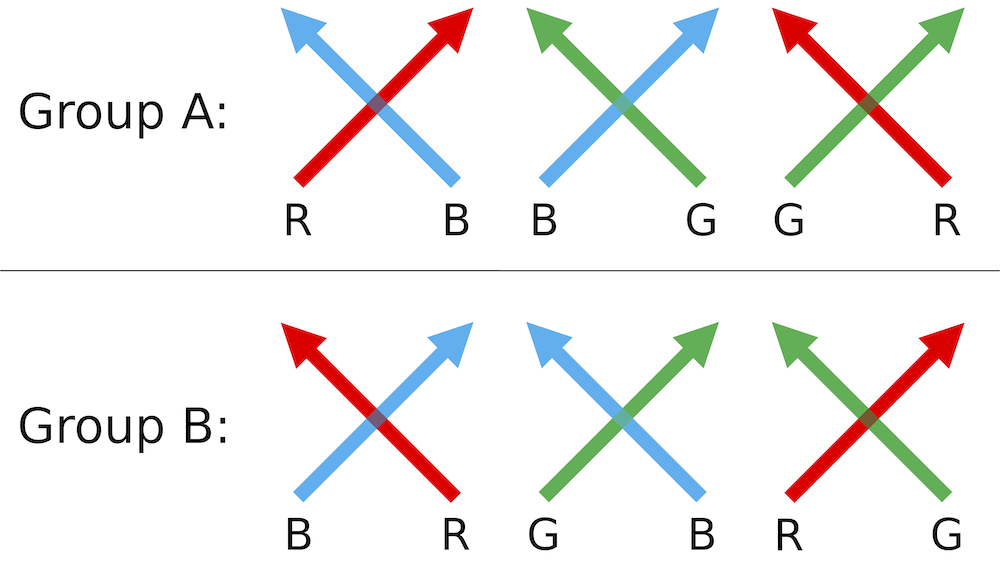2020 Qualifying Quiz
- Caitlin wants to draw n straight line segments, without lifting her pencil off the paper and without retracing her path, so that each segment crosses exactly one other segment (not counting intersections at vertices) and she ends up back where she started.
- Show how she can do this for n = 6. (Draw a picture!)
- For which n can it be done, and for which n is it impossible? Prove your answer.
-
Here is a table of remainders when powers of 10 are divided by 2020:
k 10k Remainder 0 1 1 1 10 10 2 100 100 3 1000 1000 4 10000 1920 5 100000 1020 6 1000000 100 7 10000000 1000 8 100000000 1920 9 1000000000 1020 - In addition to 2020, for what other values of m is the sequence of remainders when 10k is divided by m a fortuitous sequence?
- In addition to 10, for what other values of a is the sequence of remainders when ak is divided by 2020 a fortuitous sequence?
- An island has two cities: Mathopolis and Campville. There are three roads connecting the cities: Red Road, Green Road, and Blue Road. The roads can intersect each other, but only at right angles. Also, no road intersects itself. (Unlike in the example below, roads don't always go left to right – they can loop around and cross however they want, obeying the restrictions.) All along each road, there are signposts indicating the direction to Campville.
There are six types of intersections, which we divide into two groups:
In the example below, the red-blue crossing belongs to group A, and the red-green and green-blue crossings belong to group B.
- Find, with proof, the set of possible values of a - b under the assumption that Red Road does not intersect Green Road.
- Find the set of possible values of a - b, without the extra assumption.
- Mathematical Chunks of Sentient Protoplasm (MCSPs, for short) are smart blobs who dream of merging together into one huge blob. But they can only do it following certain rules:
- If two MCSPs have the same mass, or if their masses are 1 apart, they can merge into a single MCSP, whose mass will be the sum of the original two.
- If an MCSP has even mass, it can split into two MCSPs, each with half the original mass.
- Given a sequence of numbers, its head length is the largest integer m for which the first m terms are
nondecreasing. For instance, the head length of [1, 1, 2, 4, 3] is 4.
Thus, we can compute the average head length for any set of sequences. For example, we can evaluate the head lengths for all six permutations of the sequence [1, 2, 3]:
- [2, 1, 3], [3, 1, 2], and [3, 2, 1] each have head length 1,
- [1, 3, 2] and [2, 3, 1] have head length 2, and
- [1, 2, 3] has head length 3.
Let n be a positive integer.- Consider all the permutations of [1, 2, …, n].
- What fraction of them has head length 1?
- What fraction of them has head length k, for k < n?
- What is the average head length of a permutation of [1, 2, …, n]?
- What is the average head length of a permutation of [1, 1, 2, 3, …, n]?
- What is the average head length of a sequence of length n consisting of the numbers {1, 2, 3, 4}?
In each case, please express your answer as an explicit (rather than recursive) formula in terms of n. You may use sigma notation in your answers.
- Harini loves solving quadratic equations, but only if they have real roots. She starts with an equation
x2 + p1x + q1 = 0with p1, q1 not both 0. If the equation has two real roots, Harini uses them to create a new quadratic equation,x2 + p2x + q2 = 0,using the smaller of the two roots as p2 and the larger one as q2. For instance, if Harini's first equation was x2 + 2x − 3 = 0, which has roots −3 and 1, then her second equation would be x2 − 3x + 1 = 0. She keeps going in this way: at each step n, if the equationx2 + pnx + qn = 0has two real roots, Harini uses them as the coefficients of the next equation,x2 + pn+1x + qn+1 = 0,always with the smaller root as pn+1 and the larger root as qn+1. (A repeated root counts as two equal roots, in which case pn+1 = qn+1.) She stops when she gets to an equation that does not have real roots.
- Prove that this process cannot continue forever.
- What is the maximal possible length of Harini's sequence of equations?
Problem #4 is due to Alvin Chen, MC '18–'19. Problem #5 is due to Sean Li, MC '18. All other problems were written by the Mathcamp staff.





